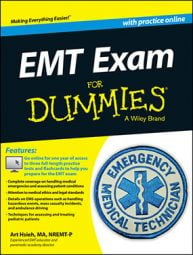Many questions on the EMT exam, as well as real situations, will involve breathing. To know when to ventilate is to know when the patient crosses the line between respiratory distress and respiratory failure:
Respiratory distress: In respiratory distress, the patient is compensating for a potential hypoxia problem by breathing faster, deeper, and/or harder. By doing so, the patient’s mental status remains good, as do his oxygen saturation levels.
Respiratory failure: If the compensatory mechanisms don’t maintain adequate oxygen or carbon dioxide levels, the patient’s well-being begins to falter. Mental status changes from alert to confused to unconsciousness as the brain runs out of oxygen or fills with carbon dioxide. Oxygen saturation levels drop below normal.
The patient’s drive to breathe weakens, causing ventilations to become inadequate. This state, in turn, makes oxygen levels fall even further, creating a vicious cycle. Breathing slows and becomes even more shallow. If left untreated, respiratory failure will deteriorate to respiratory arrest, followed quickly by cardiac arrest.
Recognizing early signs of respiratory failure is key. If the patient looks tired, is having difficulty remaining alert, or his skin becomes very pale or cyanotic, cool, and clammy, it’s time to break out your bag-valve mask (BVM) and deliver manual ventilations.
An early sign of hypoxia is anxiety. The brain is so sensitive to oxygen levels that minor changes trigger it to start sending out alerts. If your patient looks or feels anxious, definitely provide reassurance, but also consider whether you’re seeing the first signs of a more serious problem.
A 70-year-old female is complaining of shortness of breath that began shortly after a nap. She is alert and appears anxious. She is breathing 30 times per minute and says her fingers and face feel numb. You should
(A)assist with her breathing with a bag-valve mask and oxygen.
(B)provide supplemental oxygen at 4 LPM using a nasal cannula.
(C)have her breathe into a face mask without oxygen attached.
(D)tell her to control her anxiety and that will help with her breathing.
The correct answer is Choice (B). Even though she is breathing quickly, she is alert and communicating with you, which indicates she is getting enough oxygen to her brain. Therefore, she’s not in respiratory failure and doesn’t require artificial ventilation, Choice (A). However, she may be in true respiratory distress, trying to maintain oxygen levels.
The last thing you want to do is to have her rebreathe her own CO2 and reduce the amount of available oxygen, Choice (C). While she may be experiencing anxiety, she may be hyperventilating for another reason, such as having a pulmonary embolus. Choice (D), although tempting, isn’t likely to control her breathing.

